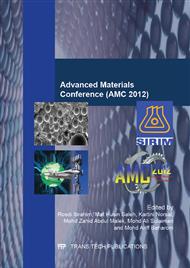[1]
Matjaz Godec, Barbara Setina Batic, Djorje Mandrino, Ales Najode, Votjeh Leskovsek, Sreco D.Skapin and Monica Jenko, Characterization of the Carbides and Martensite Phase in Powder Metallurgy High Speed Steel, MTL-06754 (2010), 1-7.
DOI: 10.1016/j.matchar.2010.02.003
Google Scholar
[2]
German, R.M and A. Bose, Injection Molding of Metals and Ceramics, Powder Injection Moulding Federation, Princeton, New Jersey, 1997.
Google Scholar
[3]
L. Moballegh, J. Morshedian and M.Esfandeh, Copper Injection Molding Using a Termoplastic binder based on Paraffin Wax, Mater.Lett, 59:2832-2837(2005)
DOI: 10.1016/j.matlet.2005.04.027
Google Scholar
[4]
G. Matula, L.A. Dobrzanski, A. Varez, B. Levenfeld, Development of A Feedstock Formulation Based on PP for MIM of Carbides Reinforced M2, JAMME, Vol.27, Issue 2 (2008).
Google Scholar
[5]
A.Varez, J.Portuondo, B. Levenfeld, J.M. Torralba, Processing of P/M T15 High Speed Steel by Mould Casting Using Thermosetting Binders, Material Chemistry and physics 67 (2001), 43-48.
DOI: 10.1016/s0254-0584(00)00418-1
Google Scholar
[6]
B. Levenfeld, A. Varez, L. Castro, J.M. Torralba (2001), Processing of P/M M2 High Speed Steels by Mould Casting Using Thermosetting Binders, Journal of Materials Processing Technology 119, 1-6.
DOI: 10.1016/s0924-0136(01)00876-7
Google Scholar
[7]
Randall M.German, Sintering Theory and Practice, 1st edition (John Wiley & Sons,inc), 1996, pp.374-426.
Google Scholar
[8]
Z.Y. Liu, N.H. Loh, K.A. Khor, S.B. Tor, Sintering of Injection Molded M2 High Speed Steel, Journal of Materials Letters 45, 32-38 (2000).
DOI: 10.1016/s0167-577x(00)00070-7
Google Scholar
[9]
Z.Y. Liu, N.H. Loh, K.A. Khor, S.B. Tor, Microstructure Evolution During Sintering of Injection Molded M2 High Speed Steel, Journal of Materials Science and Engineering A293,46-55(2000).
DOI: 10.1016/s0921-5093(00)01244-2
Google Scholar
[10]
A.Varez, B.Levenfeld, J.M. Torralba, G.Matula, L.A. Dobrzanski, Sintering in Different Atmosphere of T15 and M2 High Speed Steels Produced by Modified Metal Injection Moulding Process, Material Science and Engineering A366, 318-324 (2004).
DOI: 10.1016/j.msea.2003.08.028
Google Scholar
[11]
B.Levenfeld, A.Varez, J.M. Torralba, Effect of Residual Carbon on the Sintering Process of M2 High Speed Steel Parts Obtained by a Modified Metal Injection Molding Process, Metallurgical and Materials Transaction, Volume 33A, 1851(2002).
DOI: 10.1007/s11661-002-0192-4
Google Scholar
[12]
H.Asgharzadeh, A.Simch, Effect of Sintering Atmosphere and Carbon Content on the Densification and Microstructure of Laser Sintered M2 High Speed Steel Powder, Material Science and Engineering A403, 290-298 (2005).
DOI: 10.1016/j.msea.2005.05.017
Google Scholar


